Introduction
Picture this: You're standing in the grocery store, staring at rows of olive oil bottles. Some say "Cold Pressed," others say "First Cold Pressed," and they all claim to be the best. But what's the real difference? Is one healthier, tastier, or more authentic? If you've ever been confused by these labels, you're not alone! The truth is, marketing terms can sometimes make things seem more complicated than they really are. But don’t worry—we’re here to clear up the mystery. Let’s break it down in a way that’s easy to understand so you can choose the best olive oil with confidence.
What Does "Cold Pressed" Mean?
Let’s start with "Cold Pressed." This term refers to the process of extracting olive oil without using excessive heat or chemicals. Traditionally, olive oil was made by pressing olives with large stone mills, squeezing out their precious golden juice. Today, modern machines do the job, but the key rule remains the same: the temperature must stay below 27°C (80.6°F) during extraction.
This ensures that the oil retains its nutrients, antioxidants, and rich flavors. Keeping the temperature low is crucial because excessive heat can break down the beneficial compounds in the oil. That’s why cold-pressed olive oil is often richer in polyphenols, the natural antioxidants that provide numerous health benefits. Plus, by avoiding high heat, the oil maintains its fresh, vibrant taste—just as nature intended.
Benefits of Cold Pressed Olive Oil
✅ Better Nutrition: Since high heat isn’t used, cold-pressed olive oil keeps more of its heart-healthy antioxidants and vitamins. These antioxidants help fight inflammation and support overall wellness. The natural polyphenols in cold-pressed olive oil can also promote better heart health and brain function over time.
✅ Superior Flavor: Cold pressing preserves the natural taste of olives, giving the oil a fresh, fruity, and sometimes peppery kick. This method also enhances the complexity of flavors, making each bottle unique to its region and harvest. The balanced taste is perfect for drizzling over salads, dipping fresh bread, or enhancing your favorite dishes. Plus, the absence of excessive heat ensures that the oil retains its delicate aromatic notes.
✅ Higher Quality: Many high-end extra virgin olive oils are cold-pressed because the process ensures a pure and unrefined product. This method preserves the oil's natural aroma, taste, and nutritional value, making it a preferred choice for chefs and health-conscious consumers alike.
What About "First Cold Pressed"?
Now, here’s where things get tricky. The term "First Cold Pressed" originates from traditional olive oil production. Back in the day, olives were pressed multiple times to extract every last drop of oil. The first press was considered the best—richest in flavor, color, and nutrients. Today, with modern technology, almost all extra virgin olive oil comes from a single pressing, making the term "First Cold Pressed" a bit outdated. However, some brands continue to use it as a marketing term to imply premium quality. While it sounds impressive, it’s essential to look beyond the label and focus on factors like freshness, storage, and certification. Understanding these elements will help you choose a truly high-quality olive oil.
Does "First Cold Pressed" Matter Today?
🔹 Marketing vs. Reality: Many brands still use the term "First Cold Pressed" to imply superior quality, but in reality, most high-quality olive oil is only pressed once, making the label more of a marketing tactic than an actual distinction.
🔹 Extra Virgin Standard: If you’re buying extra virgin olive oil, it already means it’s from the first extraction and meets strict quality standards, ensuring a pure and flavorful product.
🔹 Watch for Authenticity: Some producers use "First Cold Pressed" as a buzzword, but what really matters is the quality certification on the label. Always check for PDO (Protected Designation of Origin) or PGI (Protected Geographical Indication) seals to ensure authenticity.
How to Choose the Best Olive Oil
So, if "First Cold Pressed" and "Cold Pressed" often mean the same thing today, how do you pick the best olive oil? Here are a few foolproof tips:
1️⃣ Look for Extra Virgin Olive Oil (EVOO)
If you want the best, go for Extra Virgin Olive Oil. It’s the highest grade, packed with antioxidants and free of chemicals or excessive processing.
2️⃣ Check the Bottle
Always choose dark glass bottles to protect the oil from light and keep it fresh.
3️⃣ Check the Harvest Date
Fresher is better! Olive oil is best when consumed within 12–18 months of harvest.
4️⃣ Taste Matters
High-quality olive oil should taste fresh, a little fruity, and maybe even slightly spicy. If it smells musty or rancid, it’s past its prime.
Myth Busting: Does "First Cold Pressed" Guarantee the Best Olive Oil?
Not necessarily! While the term sounds impressive, what truly matters is quality, freshness, and proper storage. Even the best "First Cold Pressed" olive oil can degrade if stored improperly. Always check the harvest date, opt for dark glass bottles, and store your oil away from heat and light. Stick to trusted brands and certifications instead of fancy marketing terms.
Conclusion: The Real Takeaway
At the end of the day, both "Cold Pressed" and "First Cold Pressed" describe similar high-quality olive oil production methods. But the best way to ensure you’re getting a top-tier product? Look for extra virgin olive oil, check the packaging, and trust reputable producers like Zagoda Olive Oil. Our commitment to quality ensures that every bottle is packed with pure, flavorful, and nutrient-rich olive oil.
Ready to experience the difference? Browse Zagoda Olive Oil Shop for premium olive oils today and taste the freshness in every drop!


